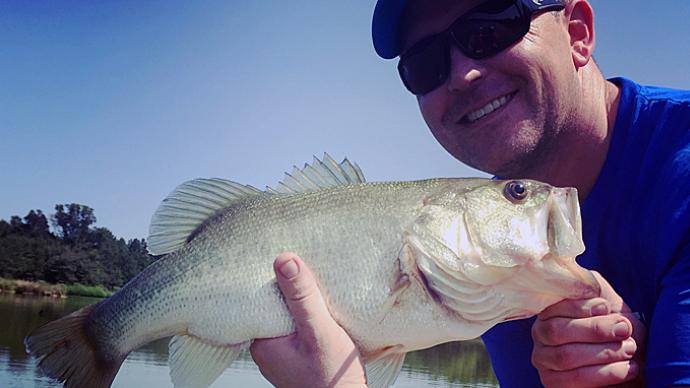
The beginning bass angler's first trip to a Bass Pro Shops or Cabela's store is a bewildering experience.
Aisles upon aisles of lures, terminal tackle, and rods and reels will make your head spin when trying to buy your startup gear for bass fishing.
Let's start with the basics of bass fishing to make those choices at the bait-and-tackle store easier for the novice angler. On top of your shopping list should be a couple of rods and reels. You need a baitcast outfit and a spinning rod and reel. Although baitcast reels are the most difficult to master, baitcasters offer the most versatility and accuracy of any reel.
For fishing lures slowly with more powerful retrieves, you will want a baitcaster with a low gear ratio of 5.1:1. A high-speed reel with a 7.1:1 gear ratio or higher works best for retrieving fast-paced lures such as buzz baits or square bill crankbaits. Match your reels with a 7 1/2-foot flipping stick for fishing around heavy cover or a 7-foot medium-heavy action rod for throwing various lures, including spinnerbaits, crankbaits, and soft plastics.
A spinning rod and reel are required for finesse fishing with light line. Combine a 3000-size reel with a 7-foot medium-action spinning rod for fishing plastic grubs and tubes and drop-shot rigs.
Your subsequent purchases should be some quality line. Fill your baitcast reels with 8- to 14-pound test monofilament for throwing jerkbaits, crankbaits, and topwater lures. Buy 14- to 20-pound fluorocarbon for working spinnerbaits, spoons, jigs, and plastic worms. Avoid using braided line until you have learned proper hook-setting tactics. Since the line has virtually no stretch, it can shatter a rod if you set the hook too hard on a fish.
The water clarity of your favorite fishing spot will determine which line size you should spool on your spinning reel. You can use 6- to 8-pound fluorocarbon for clear lakes lacking cover. In murkier water with sparse cover, you should use 10-pound test.
A bass' seasonal patterns should determine your lure purchases. In early spring on most lakes, bass leave their winter havens and suspend while migrating to the shallows in search of warmer water. The best lures to use then are suspending stickbaits such as Smithwick Rattlin' Rogues or Spro McSticks in shad patterns.

You will need to buy some crawfish-colored crankbaits once the water warms to around 45 degrees and crawfish seek the warmth of the rocky shallows. Bass will move into these rocky areas for a spring feast of crawfish. Rubber-skirted jigs tipped with plastic chunks or craws in brown/orange, black/blue, or black/brown color combinations should also be on your shopping list for this period of spring bass fishing.
Stock up on spinnerbaits for catching aggressive bass when the water temperature climbs into the 50-degree range. Spinnerbaits come in all shapes and sizes of blades. Still, the best models for springtime are usually 1/2-ounce versions with a large Colorado blade for working slowly along the bottom or 1/4-ounce models with smaller blades for active shallow fish. The best skirt colors to buy are white, chartreuse, or white/chartreuse.
Trying to buy lures for the spawn can be difficult because bass will attack a variety of baits then. A basic rule to follow is to use bigger jigs and soft plastics for fishing in murky water and heavy cover but opt for smaller ones for tempting spawning bass in clear water and sparse cover.
During the postspawn, the rigors of spawning have worn down bass, so the fish are looking for an easy meal. Topwater lures and plastic worms or lizards are your best shopping options for this seasonal pattern. The best topwater lures for postspawn bass include zigzagging cigar-style baits such as the Zara Spook or chuggers and propeller baits. A Carolina-rigged plastic worm or lizard is a highly effective method for taking postspawn bass, so you will need to buy some 1/2- or 3/4-ounce egg- or bullet-shaped weights, swivels, beads and 2/0 or 3/0 hooks for your Carolina rigs.
It's hard to beat a plastic worm for summertime bass fishing. Stock up on worms ranging in size from 8 to 12 inches and a wide range of worm weights for fishing at various depths. You should buy worm hooks ranging in size from 3/0 to 6/0 for the largest worms.
Fall is the season that could drive some beginning anglers to playing golf. The fish migrate to the shallows to chase shad, and on some days, bass will hit anything you throw, but on other days you'll be lucky if they even look at your offering. Bass prefer baitfish during this time, so your best lures will be anything that imitates a baitfish, such as buzz baits, spinnerbaits, crankbaits, and topwater lures.
When cold weather returns, bass move back to their deep-water haunts and suspend. Your lure selections drop down to three baits: suspending stickbaits, plastic grubs, and 1/2- or 3/4-ounce jigging spoons.
If you remember these seasonal patterns on your first visit to the local tackle store, you'll narrow your choices to the basics to get started in bass fishing. Then you'll be able to spend more time fishing and less time mulling around in an overloaded tackle box.
BassResource may receive a portion of revenues if you make a purchase using a link above.




